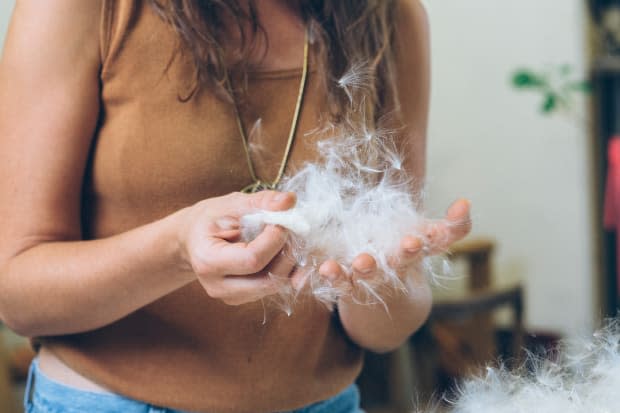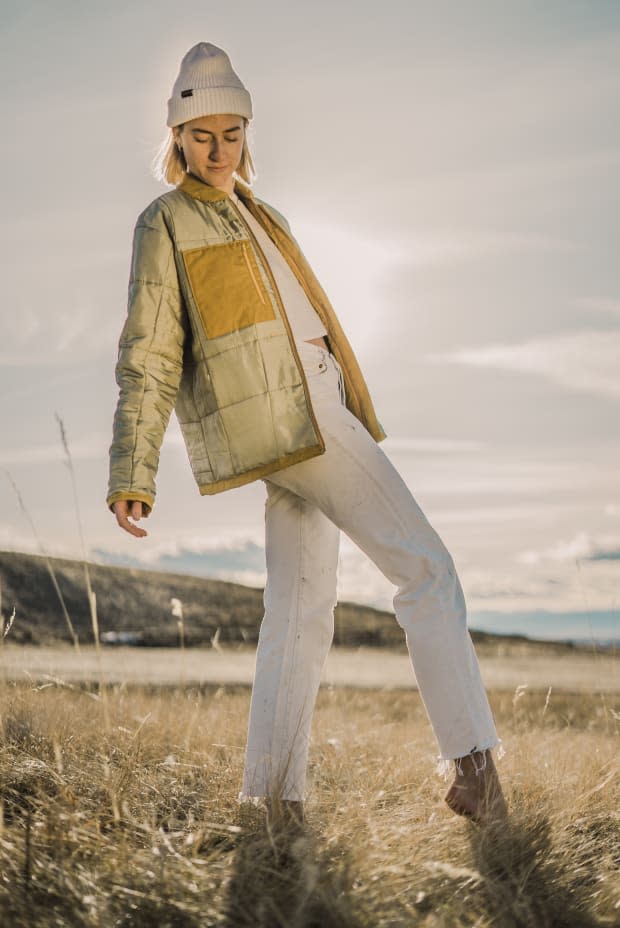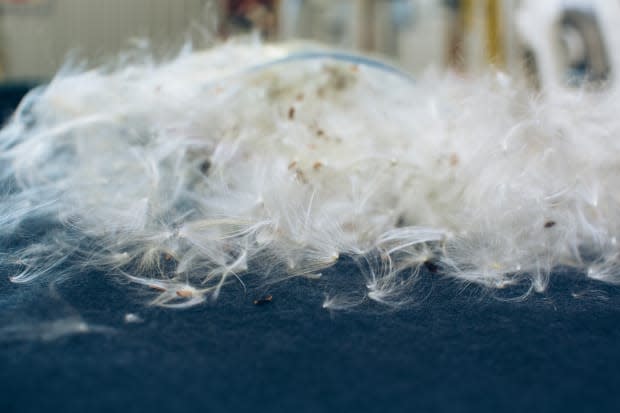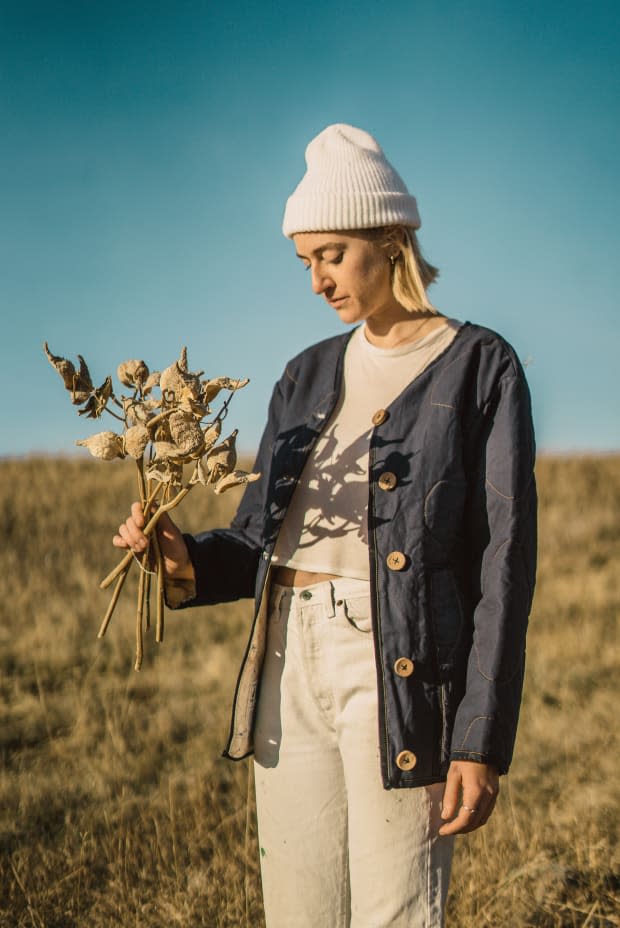The Future of Sustainable Materials: Milkweed Floss
It grows like a weed, can make a rock float and — perhaps most promising — it's six times warmer than wool, which means it could offer a plant-based alternative to down.

As sustainability becomes an increasingly pressing priority in fashion and beauty, materials with a minimal ecological impact are being sought out by a range of brands looking to shrink their environmental footprints. In our series “The Future of Sustainable Materials,” we explore the innovations that could pave the way for a brighter tomorrow.
If you were a kid living east of the Rockies in the early 1940s, there's a decent chance you might have spent some time after school combing roadsides for wild milkweed plants, whose pods you would collect in bags that could be traded for 15 cents when full. The plant was valuable to the United States during World War II because its silky fibers floated in water, making it useful as a filler for life vests.
Despite the fiber's intriguing history, it largely fell out of use after the war and the plant regained its status in the public consciousness as a pesky weed. But there are a few reasons to challenge that attitude toward milkweed: One is the crucial role it plays in supporting the lifecycle of monarchs, the iconic orange species of butterfly known for migrating from Canada to Mexico and back again. Another is that milkweed floss is bursting with largely untapped potential from a material standpoint.
Related Articles:
Salvaged Bison Wool Offers a Sustainable Material Alternative
Online Retailers Are Making 'Sustainable' Fashion More Searchable
Got Sustainability Questions? Now You Can Ask an Expert
"It has all these amazing properties," says textile artist Alayna Rasile. "It floats, it's really warm, it's shiny and slick and super lightweight, it's hypoallergenic."
Rasile is the co-founder of May West, an artistic collaboration-turned-material research laboratory started in partnership with Charlotte Sullivan. Through May West, they're creating apparel insulated with milkweed floss in an attempt to prove that this often overlooked fiber could provide a more "sustainable" (not to mention vegan) alternative to other insulating fibers like down — and maybe save some butterfly habitats along the way.
Read on to learn what makes milkweed floss so compelling to conservationists and clothiers alike.
What is it good for?
Rasile first became enamored with milkweed because of its buoyancy.
"I spun it into yarn and wrapped it around a rock and then realized it could float," she says. "It became like, 'this is magic!'"
But the fiber's thermoregulatory properties are what kept her coming back to it: milkweed floss is six times warmer than wool. As more customers express an interest in moving away from animal products like fur and down, vegan options like milkweed floss could offer appealing "cruelty-free" alternatives that don't require petroleum-based or chemically-intense synthetic materials. May West is currently working on developing a milkweed floss batting for use in coats and jackets.
Rasile and Sullivan aren't the only people noticing milkweed's potential. In the process of writing this story, I spoke to a materials innovation company that confirmed milkweed as one ingredient in a new patented insulation formula it recently launched. The company later asked not to be named, underscoring how valuable they think this material could become as more people catch on to its desirable qualities.

What makes it an environmentally friendly option?
Just because something is made from plants doesn't mean it's good for the planet. But in milkweed's case, creating more demand for the plant would be enough to have a positive impact. According to the U.S. Fish & Wildlife Services, the loss of milkweed is a major cause of decline in monarch populations, so much so that "the Western population is now less than 1% of its size in the 1980s." Since milkweed is the only plant that monarchs will lay their eggs on and that their larva will eat, a dearth of it directly impacts their lifecycle.
Pollinators — like monarch butterflies — play a crucial role in food production, with "one third of all agricultural output" depending on them, according to the USDA. To Rasile, monarchs are a useful symbol for thinking about pollinators and their role more broadly.
"They're a biological indicator that kind of stands for all pollinators," she explains. "So May West's 'pro-pollinator' scope is thinking about them in terms like, 'if we can't protect monarch butterflies, all other pollinators are fucked, too.'"
At the moment, most people treat milkweed as a pest, mowing it down or spraying it with herbicides when it pops up near their fields or by the side of the road. Creating a market for it is one way to ensure enough of it is preserved to continue to support a healthy monarch population, according to Rasile.
"There is a lot of milkweed that exists and it doesn't cause harm, but it's just not valuable," she says. "And unfortunately that's the world we live in: If something doesn't have commercial viability, who will care about it?"
Luckily, harvesting the floss from milkweed seedpods doesn't happen until after monarchs are done using the plant each season, so collecting the floss doesn't disrupt the insects. Plus, milkweed spreads underground, which means that harvesting the seed pods doesn't even have to harm individual plants.

How is it produced?
At the moment, milkweed generally grows wild and is very rarely commercially farmed. May West gets its milkweed from partners in Nebraska who source it much the same way it was sourced during WWII: by offering to pay community members who gather it wherever they find it growing wild.
"They're getting a genetically diverse crop and providing income for economically depressed areas, so that's cool," Rasile says.
There are a few people trying to farm milkweed as a monocrop in places like Vermont and Quebec, she notes, and that could help make it easier to get the material in bulk, especially if those agriculturalists can figure out how to properly modify farm equipment to harvest milkweed floss specifically. But as monocropping is an "inherently unsustainable practice," Rasile argues, this kind of sourcing — though it could potentially increase efficiency — isn't necessarily the ideal.
What are the challenges?
As a result of this sourcing setup, scalability is one of the biggest challenges facing May West and other brands that wish to incorporate milkweed floss into their clothing.
"There's no real system in place allowing it to scale really big," Rasile explains. "And if it can't be big, that means it can't be cheap."
Rasile is hopeful that if farmers can be convinced to see it as a supplementary cash crop, they'll be more likely to let it grow at the edges of their fields. (Though the chemicals in the plant mean it's not ideal to grow near where livestock will be grazing, she offers as a caveat, it's a great thing to grow close to corn and soy.) She's also hopeful that new uses could emerge for other parts of the plant besides the seedpod floss, which could add further value for growers.
Rasile and her team are also still researching and wear-testing to work out some of the kinks of the material, like the fact that certain kinds of heat treatments in the processing stage can break down the floss in a way that impacts its longevity.

What's next for milkweed?
At the moment, May West is still doing material research to thoroughly prove the concept of milkweed's worthiness as a clothing fiber. But as independent research continues to happen in other places (like that not-to-be-named materials innovation company) and as Rasile and Sullivan communicate their own findings to their peers, they're starting to see more and more industry interest in the material.
Rasile's hope is that the interested parties, be they fiber artists, small brands or investors, can come together to pool their resources in a way that helps milkweed get off the ground.
"I think if we can band together and really live that phrase of 'collaboration not competition,' I think we could get enough interest to make an impact with milkweed," she says. "If we all buy into it together, we could figure out how to scale it."
